Strategic Analysis: Disneyland Park's Core Competencies & Strengths
VerifiedAdded on 2023/06/13
|10
|2126
|112
Report
AI Summary
This report provides a comprehensive analysis of Disneyland Park's business strategy, focusing on its value chain, core competencies, and competitive advantages. The analysis covers Disneyland's firm infrastructure, human resources, technology, and procurement processes, as well as primary activities such as inbound logistics, operations, outbound logistics, marketing and sales, and services. It identifies leadership and employee engagement as core competencies, highlighting how these contribute to the organization's success. The report also addresses key issues facing the company, including planning challenges, website malfunctions, lack of standardized rules, and competition from other theme parks. Finally, it discusses potential company responses, such as service development and market penetration strategies, to maintain its competitive edge. Desklib provides access to this and other solved assignments for students' educational needs.
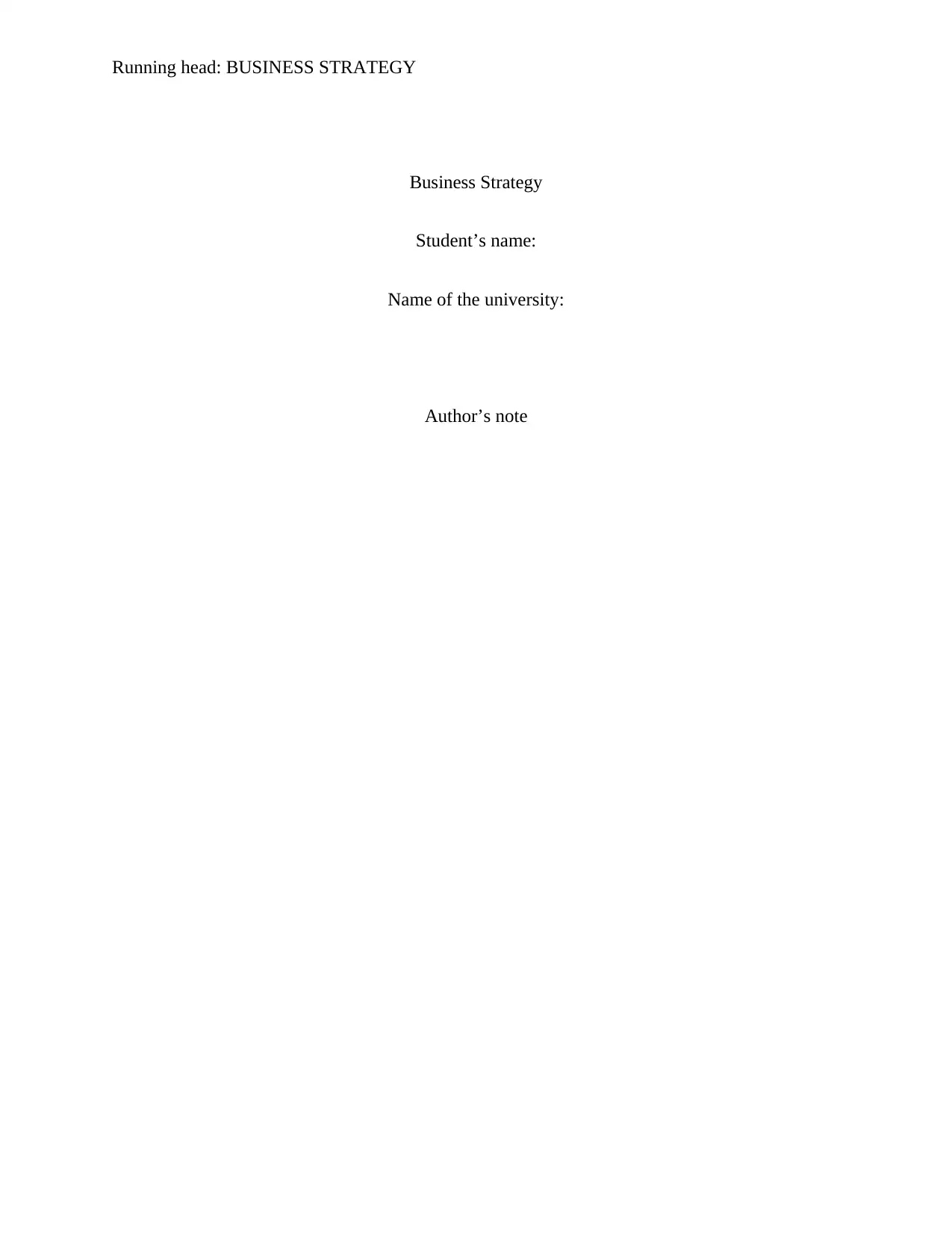
Running head: BUSINESS STRATEGY
Business Strategy
Student’s name:
Name of the university:
Author’s note
Business Strategy
Student’s name:
Name of the university:
Author’s note
Paraphrase This Document
Need a fresh take? Get an instant paraphrase of this document with our AI Paraphraser
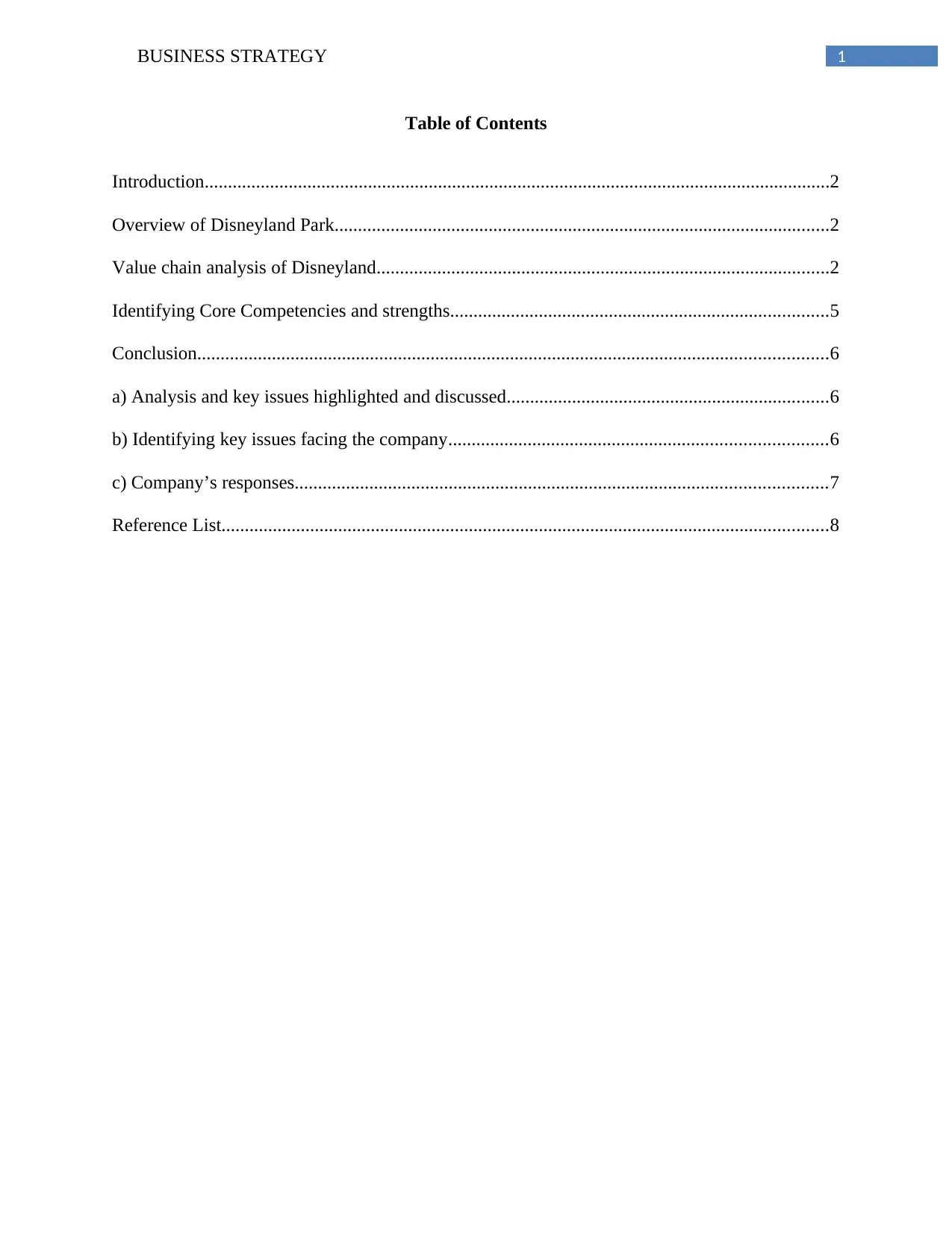
1BUSINESS STRATEGY
Table of Contents
Introduction......................................................................................................................................2
Overview of Disneyland Park..........................................................................................................2
Value chain analysis of Disneyland.................................................................................................2
Identifying Core Competencies and strengths.................................................................................5
Conclusion.......................................................................................................................................6
a) Analysis and key issues highlighted and discussed.....................................................................6
b) Identifying key issues facing the company.................................................................................6
c) Company’s responses..................................................................................................................7
Reference List..................................................................................................................................8
Table of Contents
Introduction......................................................................................................................................2
Overview of Disneyland Park..........................................................................................................2
Value chain analysis of Disneyland.................................................................................................2
Identifying Core Competencies and strengths.................................................................................5
Conclusion.......................................................................................................................................6
a) Analysis and key issues highlighted and discussed.....................................................................6
b) Identifying key issues facing the company.................................................................................6
c) Company’s responses..................................................................................................................7
Reference List..................................................................................................................................8
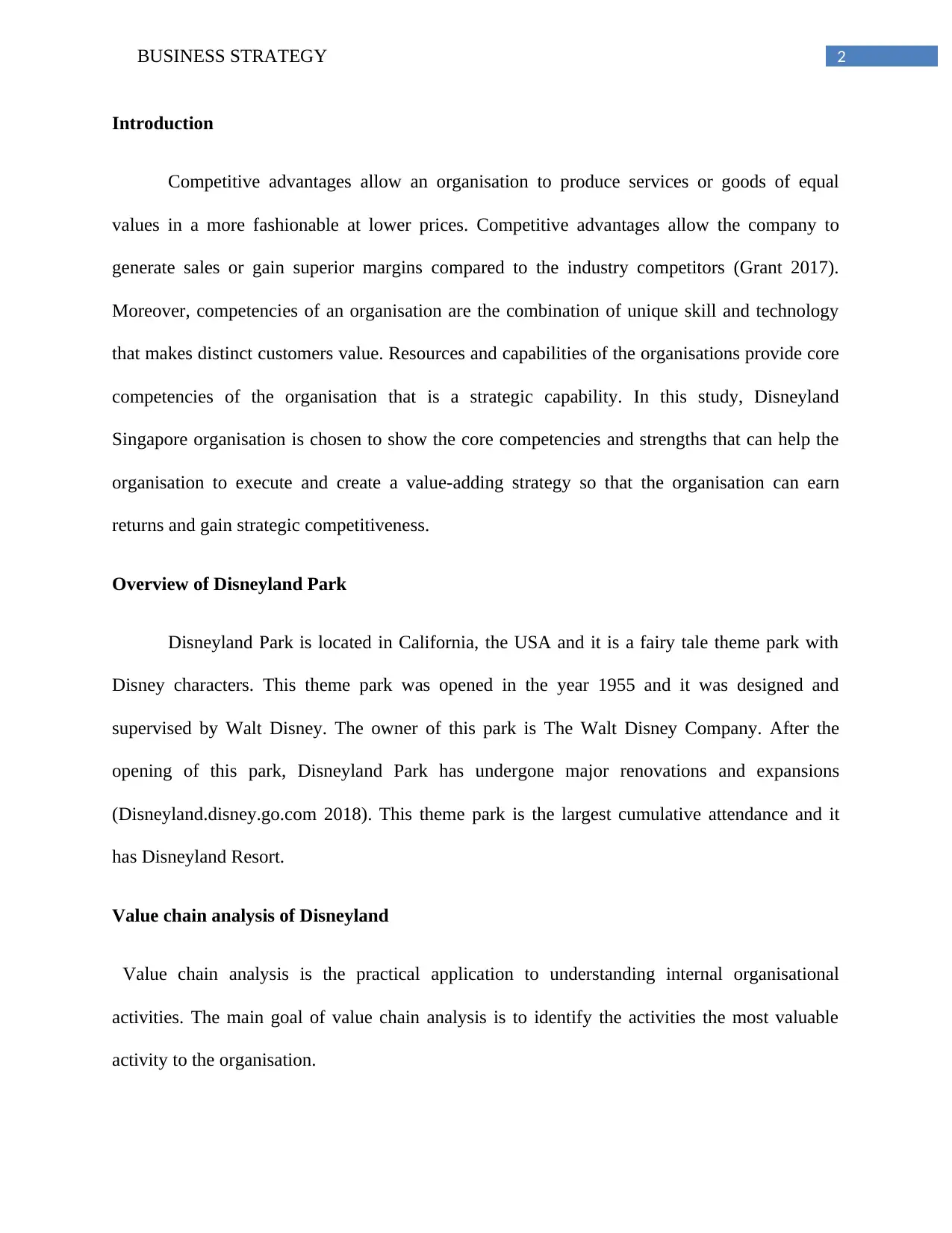
2BUSINESS STRATEGY
Introduction
Competitive advantages allow an organisation to produce services or goods of equal
values in a more fashionable at lower prices. Competitive advantages allow the company to
generate sales or gain superior margins compared to the industry competitors (Grant 2017).
Moreover, competencies of an organisation are the combination of unique skill and technology
that makes distinct customers value. Resources and capabilities of the organisations provide core
competencies of the organisation that is a strategic capability. In this study, Disneyland
Singapore organisation is chosen to show the core competencies and strengths that can help the
organisation to execute and create a value-adding strategy so that the organisation can earn
returns and gain strategic competitiveness.
Overview of Disneyland Park
Disneyland Park is located in California, the USA and it is a fairy tale theme park with
Disney characters. This theme park was opened in the year 1955 and it was designed and
supervised by Walt Disney. The owner of this park is The Walt Disney Company. After the
opening of this park, Disneyland Park has undergone major renovations and expansions
(Disneyland.disney.go.com 2018). This theme park is the largest cumulative attendance and it
has Disneyland Resort.
Value chain analysis of Disneyland
Value chain analysis is the practical application to understanding internal organisational
activities. The main goal of value chain analysis is to identify the activities the most valuable
activity to the organisation.
Introduction
Competitive advantages allow an organisation to produce services or goods of equal
values in a more fashionable at lower prices. Competitive advantages allow the company to
generate sales or gain superior margins compared to the industry competitors (Grant 2017).
Moreover, competencies of an organisation are the combination of unique skill and technology
that makes distinct customers value. Resources and capabilities of the organisations provide core
competencies of the organisation that is a strategic capability. In this study, Disneyland
Singapore organisation is chosen to show the core competencies and strengths that can help the
organisation to execute and create a value-adding strategy so that the organisation can earn
returns and gain strategic competitiveness.
Overview of Disneyland Park
Disneyland Park is located in California, the USA and it is a fairy tale theme park with
Disney characters. This theme park was opened in the year 1955 and it was designed and
supervised by Walt Disney. The owner of this park is The Walt Disney Company. After the
opening of this park, Disneyland Park has undergone major renovations and expansions
(Disneyland.disney.go.com 2018). This theme park is the largest cumulative attendance and it
has Disneyland Resort.
Value chain analysis of Disneyland
Value chain analysis is the practical application to understanding internal organisational
activities. The main goal of value chain analysis is to identify the activities the most valuable
activity to the organisation.
⊘ This is a preview!⊘
Do you want full access?
Subscribe today to unlock all pages.

Trusted by 1+ million students worldwide
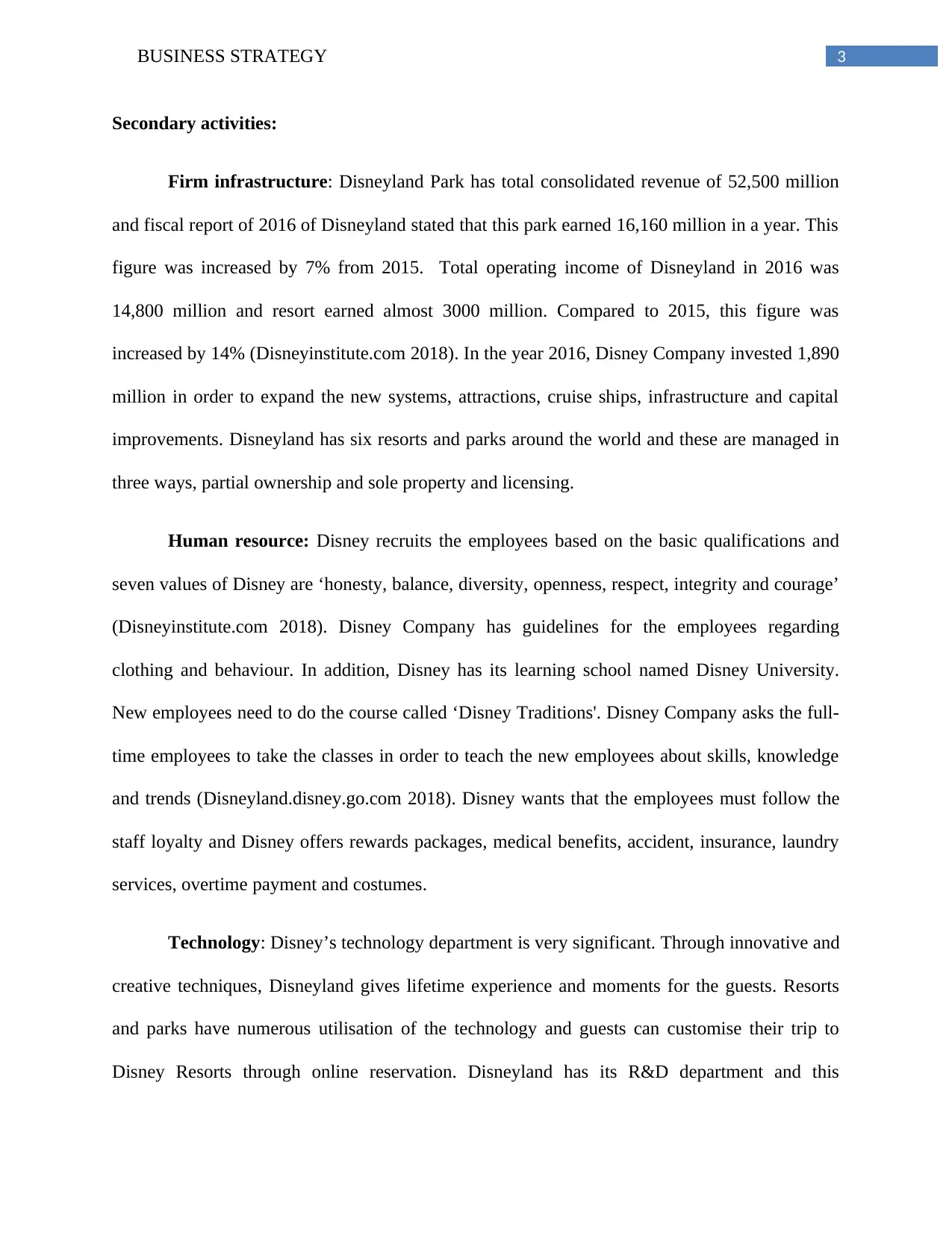
3BUSINESS STRATEGY
Secondary activities:
Firm infrastructure: Disneyland Park has total consolidated revenue of 52,500 million
and fiscal report of 2016 of Disneyland stated that this park earned 16,160 million in a year. This
figure was increased by 7% from 2015. Total operating income of Disneyland in 2016 was
14,800 million and resort earned almost 3000 million. Compared to 2015, this figure was
increased by 14% (Disneyinstitute.com 2018). In the year 2016, Disney Company invested 1,890
million in order to expand the new systems, attractions, cruise ships, infrastructure and capital
improvements. Disneyland has six resorts and parks around the world and these are managed in
three ways, partial ownership and sole property and licensing.
Human resource: Disney recruits the employees based on the basic qualifications and
seven values of Disney are ‘honesty, balance, diversity, openness, respect, integrity and courage’
(Disneyinstitute.com 2018). Disney Company has guidelines for the employees regarding
clothing and behaviour. In addition, Disney has its learning school named Disney University.
New employees need to do the course called ‘Disney Traditions'. Disney Company asks the full-
time employees to take the classes in order to teach the new employees about skills, knowledge
and trends (Disneyland.disney.go.com 2018). Disney wants that the employees must follow the
staff loyalty and Disney offers rewards packages, medical benefits, accident, insurance, laundry
services, overtime payment and costumes.
Technology: Disney’s technology department is very significant. Through innovative and
creative techniques, Disneyland gives lifetime experience and moments for the guests. Resorts
and parks have numerous utilisation of the technology and guests can customise their trip to
Disney Resorts through online reservation. Disneyland has its R&D department and this
Secondary activities:
Firm infrastructure: Disneyland Park has total consolidated revenue of 52,500 million
and fiscal report of 2016 of Disneyland stated that this park earned 16,160 million in a year. This
figure was increased by 7% from 2015. Total operating income of Disneyland in 2016 was
14,800 million and resort earned almost 3000 million. Compared to 2015, this figure was
increased by 14% (Disneyinstitute.com 2018). In the year 2016, Disney Company invested 1,890
million in order to expand the new systems, attractions, cruise ships, infrastructure and capital
improvements. Disneyland has six resorts and parks around the world and these are managed in
three ways, partial ownership and sole property and licensing.
Human resource: Disney recruits the employees based on the basic qualifications and
seven values of Disney are ‘honesty, balance, diversity, openness, respect, integrity and courage’
(Disneyinstitute.com 2018). Disney Company has guidelines for the employees regarding
clothing and behaviour. In addition, Disney has its learning school named Disney University.
New employees need to do the course called ‘Disney Traditions'. Disney Company asks the full-
time employees to take the classes in order to teach the new employees about skills, knowledge
and trends (Disneyland.disney.go.com 2018). Disney wants that the employees must follow the
staff loyalty and Disney offers rewards packages, medical benefits, accident, insurance, laundry
services, overtime payment and costumes.
Technology: Disney’s technology department is very significant. Through innovative and
creative techniques, Disneyland gives lifetime experience and moments for the guests. Resorts
and parks have numerous utilisation of the technology and guests can customise their trip to
Disney Resorts through online reservation. Disneyland has its R&D department and this
Paraphrase This Document
Need a fresh take? Get an instant paraphrase of this document with our AI Paraphraser
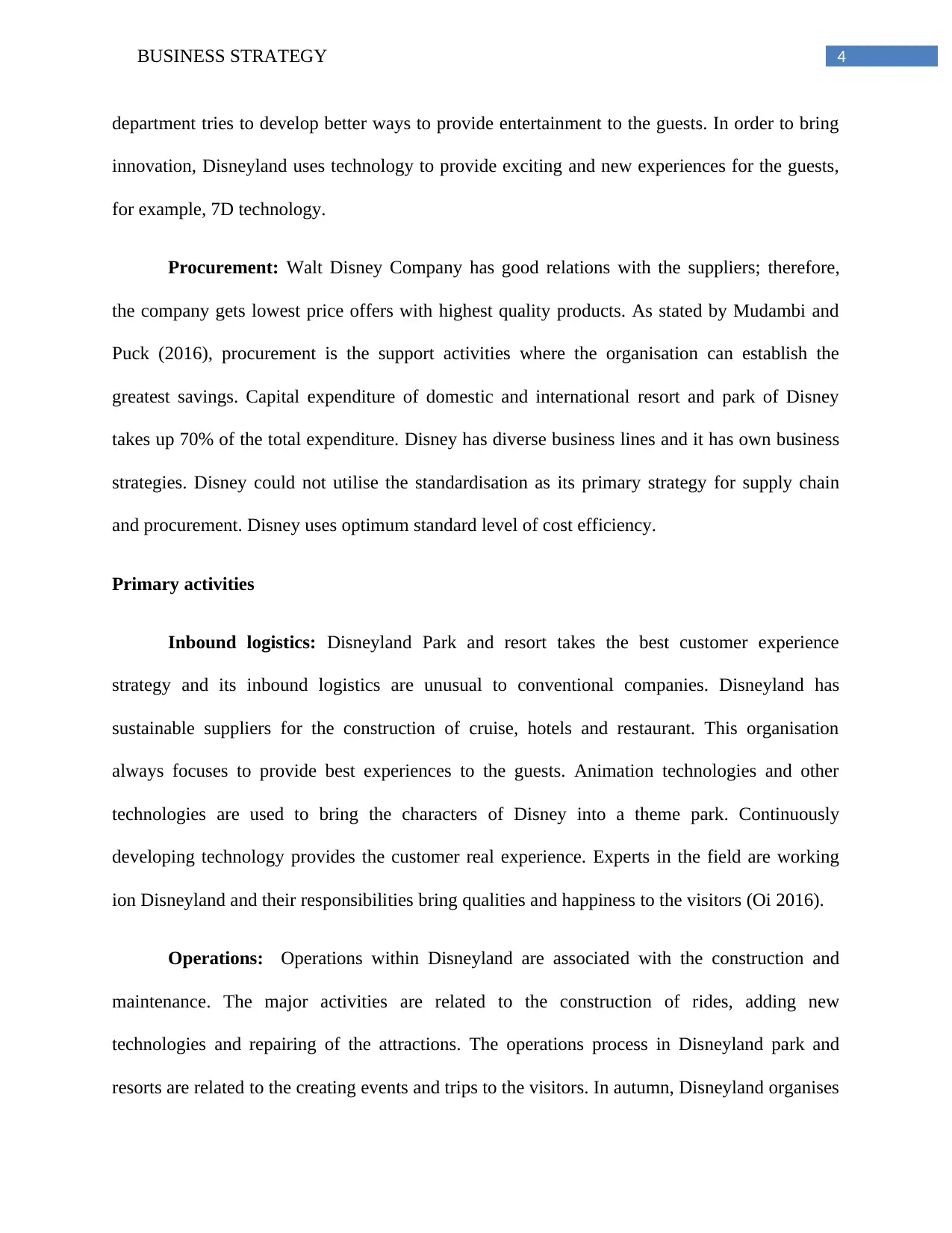
4BUSINESS STRATEGY
department tries to develop better ways to provide entertainment to the guests. In order to bring
innovation, Disneyland uses technology to provide exciting and new experiences for the guests,
for example, 7D technology.
Procurement: Walt Disney Company has good relations with the suppliers; therefore,
the company gets lowest price offers with highest quality products. As stated by Mudambi and
Puck (2016), procurement is the support activities where the organisation can establish the
greatest savings. Capital expenditure of domestic and international resort and park of Disney
takes up 70% of the total expenditure. Disney has diverse business lines and it has own business
strategies. Disney could not utilise the standardisation as its primary strategy for supply chain
and procurement. Disney uses optimum standard level of cost efficiency.
Primary activities
Inbound logistics: Disneyland Park and resort takes the best customer experience
strategy and its inbound logistics are unusual to conventional companies. Disneyland has
sustainable suppliers for the construction of cruise, hotels and restaurant. This organisation
always focuses to provide best experiences to the guests. Animation technologies and other
technologies are used to bring the characters of Disney into a theme park. Continuously
developing technology provides the customer real experience. Experts in the field are working
ion Disneyland and their responsibilities bring qualities and happiness to the visitors (Oi 2016).
Operations: Operations within Disneyland are associated with the construction and
maintenance. The major activities are related to the construction of rides, adding new
technologies and repairing of the attractions. The operations process in Disneyland park and
resorts are related to the creating events and trips to the visitors. In autumn, Disneyland organises
department tries to develop better ways to provide entertainment to the guests. In order to bring
innovation, Disneyland uses technology to provide exciting and new experiences for the guests,
for example, 7D technology.
Procurement: Walt Disney Company has good relations with the suppliers; therefore,
the company gets lowest price offers with highest quality products. As stated by Mudambi and
Puck (2016), procurement is the support activities where the organisation can establish the
greatest savings. Capital expenditure of domestic and international resort and park of Disney
takes up 70% of the total expenditure. Disney has diverse business lines and it has own business
strategies. Disney could not utilise the standardisation as its primary strategy for supply chain
and procurement. Disney uses optimum standard level of cost efficiency.
Primary activities
Inbound logistics: Disneyland Park and resort takes the best customer experience
strategy and its inbound logistics are unusual to conventional companies. Disneyland has
sustainable suppliers for the construction of cruise, hotels and restaurant. This organisation
always focuses to provide best experiences to the guests. Animation technologies and other
technologies are used to bring the characters of Disney into a theme park. Continuously
developing technology provides the customer real experience. Experts in the field are working
ion Disneyland and their responsibilities bring qualities and happiness to the visitors (Oi 2016).
Operations: Operations within Disneyland are associated with the construction and
maintenance. The major activities are related to the construction of rides, adding new
technologies and repairing of the attractions. The operations process in Disneyland park and
resorts are related to the creating events and trips to the visitors. In autumn, Disneyland organises
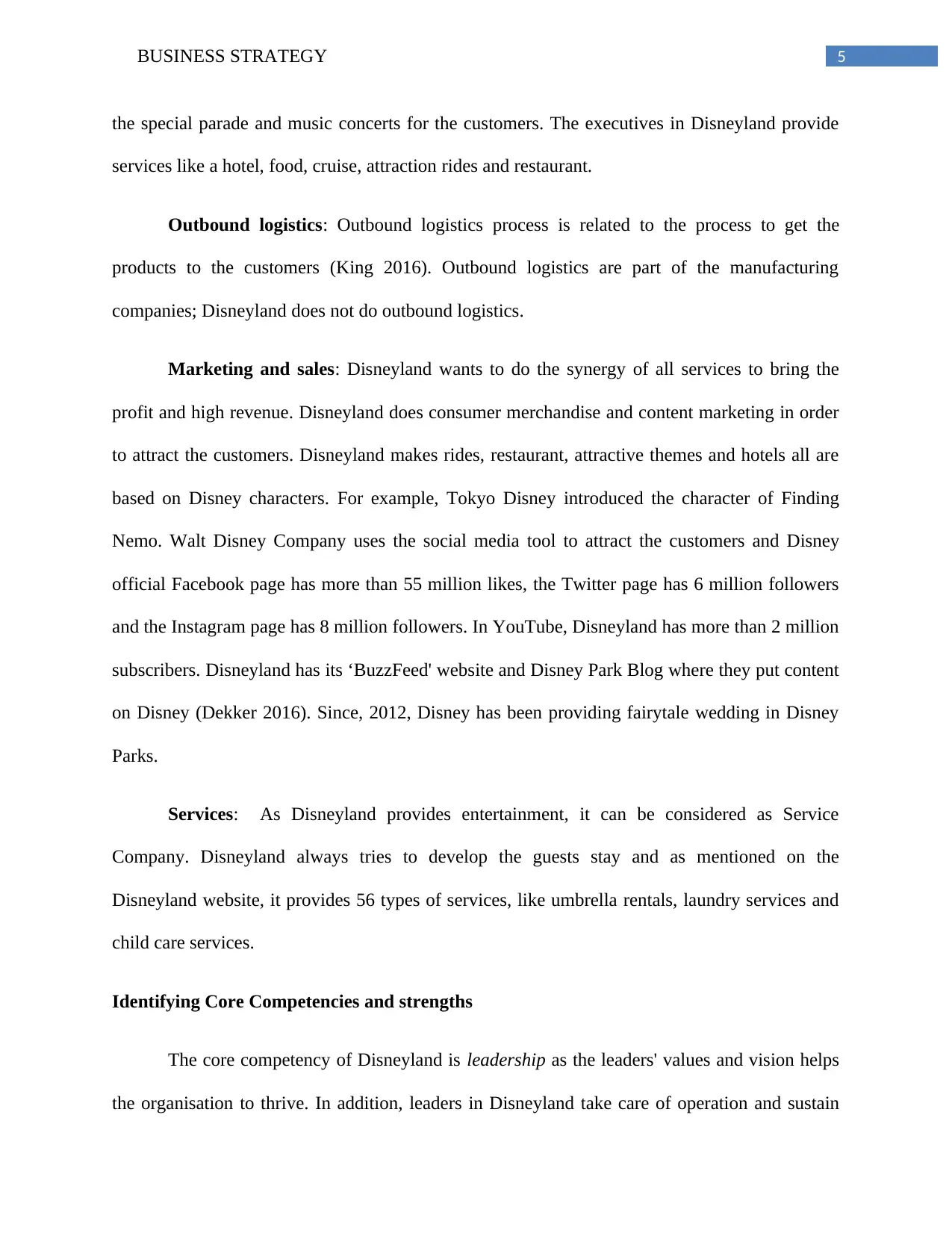
5BUSINESS STRATEGY
the special parade and music concerts for the customers. The executives in Disneyland provide
services like a hotel, food, cruise, attraction rides and restaurant.
Outbound logistics: Outbound logistics process is related to the process to get the
products to the customers (King 2016). Outbound logistics are part of the manufacturing
companies; Disneyland does not do outbound logistics.
Marketing and sales: Disneyland wants to do the synergy of all services to bring the
profit and high revenue. Disneyland does consumer merchandise and content marketing in order
to attract the customers. Disneyland makes rides, restaurant, attractive themes and hotels all are
based on Disney characters. For example, Tokyo Disney introduced the character of Finding
Nemo. Walt Disney Company uses the social media tool to attract the customers and Disney
official Facebook page has more than 55 million likes, the Twitter page has 6 million followers
and the Instagram page has 8 million followers. In YouTube, Disneyland has more than 2 million
subscribers. Disneyland has its ‘BuzzFeed' website and Disney Park Blog where they put content
on Disney (Dekker 2016). Since, 2012, Disney has been providing fairytale wedding in Disney
Parks.
Services: As Disneyland provides entertainment, it can be considered as Service
Company. Disneyland always tries to develop the guests stay and as mentioned on the
Disneyland website, it provides 56 types of services, like umbrella rentals, laundry services and
child care services.
Identifying Core Competencies and strengths
The core competency of Disneyland is leadership as the leaders' values and vision helps
the organisation to thrive. In addition, leaders in Disneyland take care of operation and sustain
the special parade and music concerts for the customers. The executives in Disneyland provide
services like a hotel, food, cruise, attraction rides and restaurant.
Outbound logistics: Outbound logistics process is related to the process to get the
products to the customers (King 2016). Outbound logistics are part of the manufacturing
companies; Disneyland does not do outbound logistics.
Marketing and sales: Disneyland wants to do the synergy of all services to bring the
profit and high revenue. Disneyland does consumer merchandise and content marketing in order
to attract the customers. Disneyland makes rides, restaurant, attractive themes and hotels all are
based on Disney characters. For example, Tokyo Disney introduced the character of Finding
Nemo. Walt Disney Company uses the social media tool to attract the customers and Disney
official Facebook page has more than 55 million likes, the Twitter page has 6 million followers
and the Instagram page has 8 million followers. In YouTube, Disneyland has more than 2 million
subscribers. Disneyland has its ‘BuzzFeed' website and Disney Park Blog where they put content
on Disney (Dekker 2016). Since, 2012, Disney has been providing fairytale wedding in Disney
Parks.
Services: As Disneyland provides entertainment, it can be considered as Service
Company. Disneyland always tries to develop the guests stay and as mentioned on the
Disneyland website, it provides 56 types of services, like umbrella rentals, laundry services and
child care services.
Identifying Core Competencies and strengths
The core competency of Disneyland is leadership as the leaders' values and vision helps
the organisation to thrive. In addition, leaders in Disneyland take care of operation and sustain
⊘ This is a preview!⊘
Do you want full access?
Subscribe today to unlock all pages.

Trusted by 1+ million students worldwide
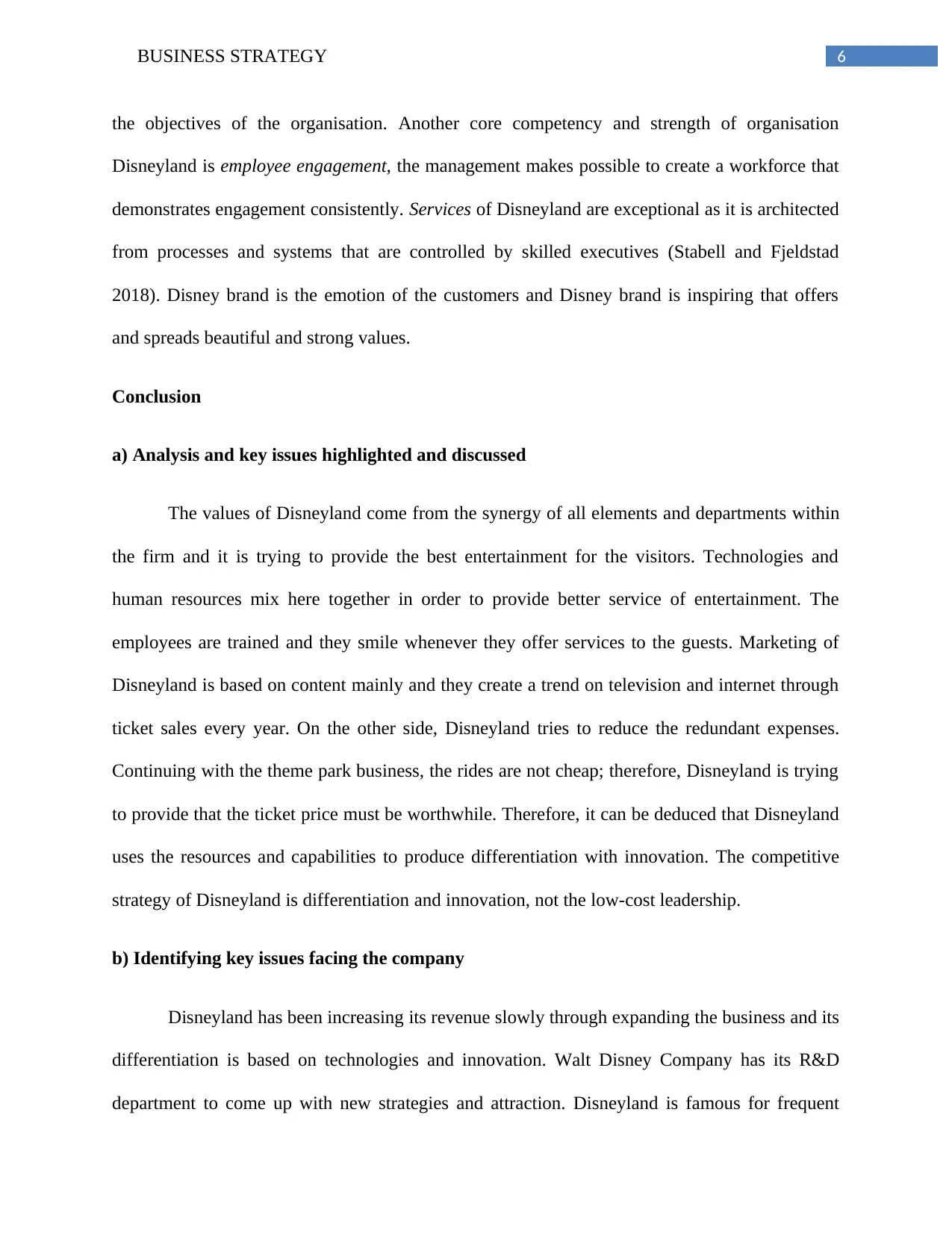
6BUSINESS STRATEGY
the objectives of the organisation. Another core competency and strength of organisation
Disneyland is employee engagement, the management makes possible to create a workforce that
demonstrates engagement consistently. Services of Disneyland are exceptional as it is architected
from processes and systems that are controlled by skilled executives (Stabell and Fjeldstad
2018). Disney brand is the emotion of the customers and Disney brand is inspiring that offers
and spreads beautiful and strong values.
Conclusion
a) Analysis and key issues highlighted and discussed
The values of Disneyland come from the synergy of all elements and departments within
the firm and it is trying to provide the best entertainment for the visitors. Technologies and
human resources mix here together in order to provide better service of entertainment. The
employees are trained and they smile whenever they offer services to the guests. Marketing of
Disneyland is based on content mainly and they create a trend on television and internet through
ticket sales every year. On the other side, Disneyland tries to reduce the redundant expenses.
Continuing with the theme park business, the rides are not cheap; therefore, Disneyland is trying
to provide that the ticket price must be worthwhile. Therefore, it can be deduced that Disneyland
uses the resources and capabilities to produce differentiation with innovation. The competitive
strategy of Disneyland is differentiation and innovation, not the low-cost leadership.
b) Identifying key issues facing the company
Disneyland has been increasing its revenue slowly through expanding the business and its
differentiation is based on technologies and innovation. Walt Disney Company has its R&D
department to come up with new strategies and attraction. Disneyland is famous for frequent
the objectives of the organisation. Another core competency and strength of organisation
Disneyland is employee engagement, the management makes possible to create a workforce that
demonstrates engagement consistently. Services of Disneyland are exceptional as it is architected
from processes and systems that are controlled by skilled executives (Stabell and Fjeldstad
2018). Disney brand is the emotion of the customers and Disney brand is inspiring that offers
and spreads beautiful and strong values.
Conclusion
a) Analysis and key issues highlighted and discussed
The values of Disneyland come from the synergy of all elements and departments within
the firm and it is trying to provide the best entertainment for the visitors. Technologies and
human resources mix here together in order to provide better service of entertainment. The
employees are trained and they smile whenever they offer services to the guests. Marketing of
Disneyland is based on content mainly and they create a trend on television and internet through
ticket sales every year. On the other side, Disneyland tries to reduce the redundant expenses.
Continuing with the theme park business, the rides are not cheap; therefore, Disneyland is trying
to provide that the ticket price must be worthwhile. Therefore, it can be deduced that Disneyland
uses the resources and capabilities to produce differentiation with innovation. The competitive
strategy of Disneyland is differentiation and innovation, not the low-cost leadership.
b) Identifying key issues facing the company
Disneyland has been increasing its revenue slowly through expanding the business and its
differentiation is based on technologies and innovation. Walt Disney Company has its R&D
department to come up with new strategies and attraction. Disneyland is famous for frequent
Paraphrase This Document
Need a fresh take? Get an instant paraphrase of this document with our AI Paraphraser
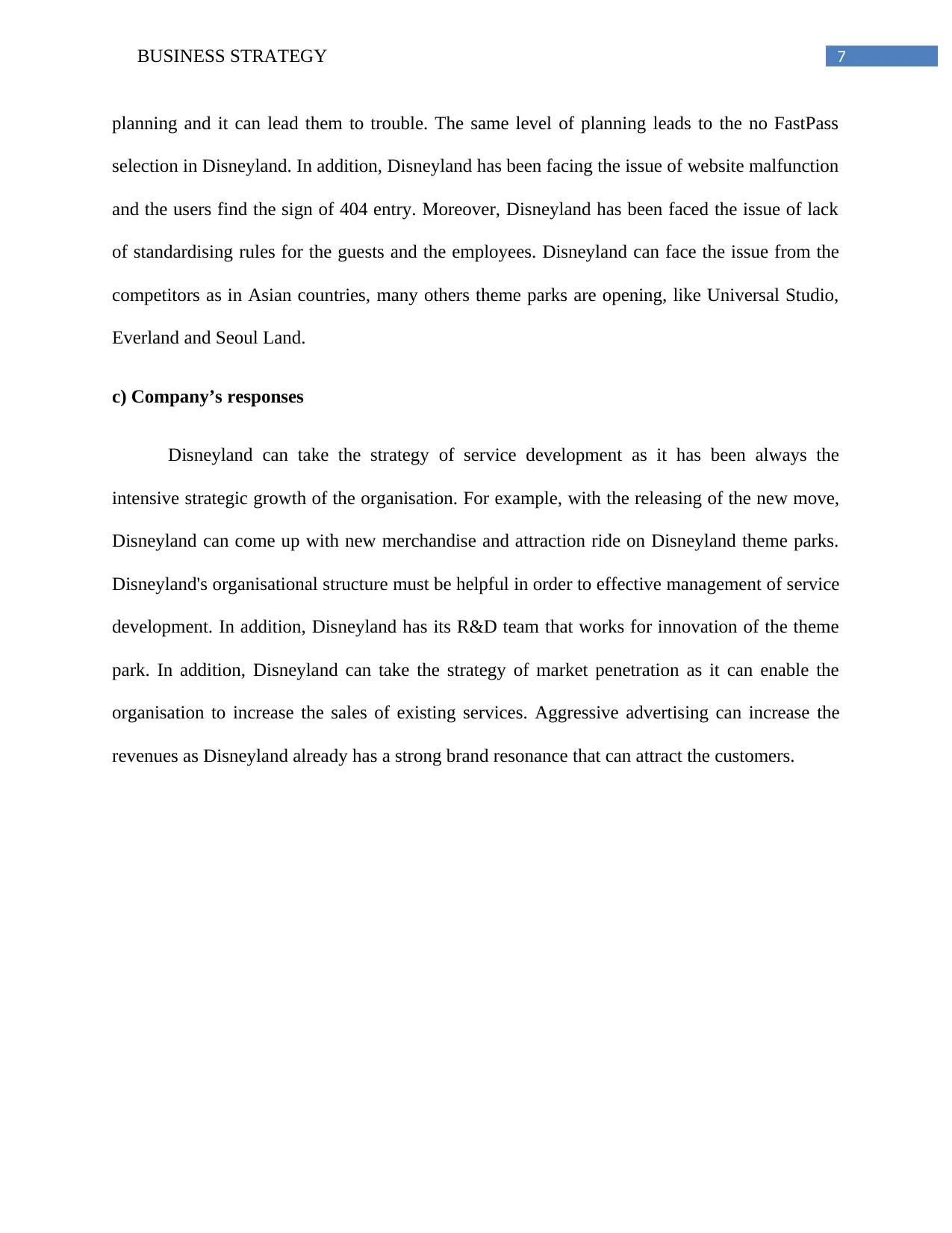
7BUSINESS STRATEGY
planning and it can lead them to trouble. The same level of planning leads to the no FastPass
selection in Disneyland. In addition, Disneyland has been facing the issue of website malfunction
and the users find the sign of 404 entry. Moreover, Disneyland has been faced the issue of lack
of standardising rules for the guests and the employees. Disneyland can face the issue from the
competitors as in Asian countries, many others theme parks are opening, like Universal Studio,
Everland and Seoul Land.
c) Company’s responses
Disneyland can take the strategy of service development as it has been always the
intensive strategic growth of the organisation. For example, with the releasing of the new move,
Disneyland can come up with new merchandise and attraction ride on Disneyland theme parks.
Disneyland's organisational structure must be helpful in order to effective management of service
development. In addition, Disneyland has its R&D team that works for innovation of the theme
park. In addition, Disneyland can take the strategy of market penetration as it can enable the
organisation to increase the sales of existing services. Aggressive advertising can increase the
revenues as Disneyland already has a strong brand resonance that can attract the customers.
planning and it can lead them to trouble. The same level of planning leads to the no FastPass
selection in Disneyland. In addition, Disneyland has been facing the issue of website malfunction
and the users find the sign of 404 entry. Moreover, Disneyland has been faced the issue of lack
of standardising rules for the guests and the employees. Disneyland can face the issue from the
competitors as in Asian countries, many others theme parks are opening, like Universal Studio,
Everland and Seoul Land.
c) Company’s responses
Disneyland can take the strategy of service development as it has been always the
intensive strategic growth of the organisation. For example, with the releasing of the new move,
Disneyland can come up with new merchandise and attraction ride on Disneyland theme parks.
Disneyland's organisational structure must be helpful in order to effective management of service
development. In addition, Disneyland has its R&D team that works for innovation of the theme
park. In addition, Disneyland can take the strategy of market penetration as it can enable the
organisation to increase the sales of existing services. Aggressive advertising can increase the
revenues as Disneyland already has a strong brand resonance that can attract the customers.
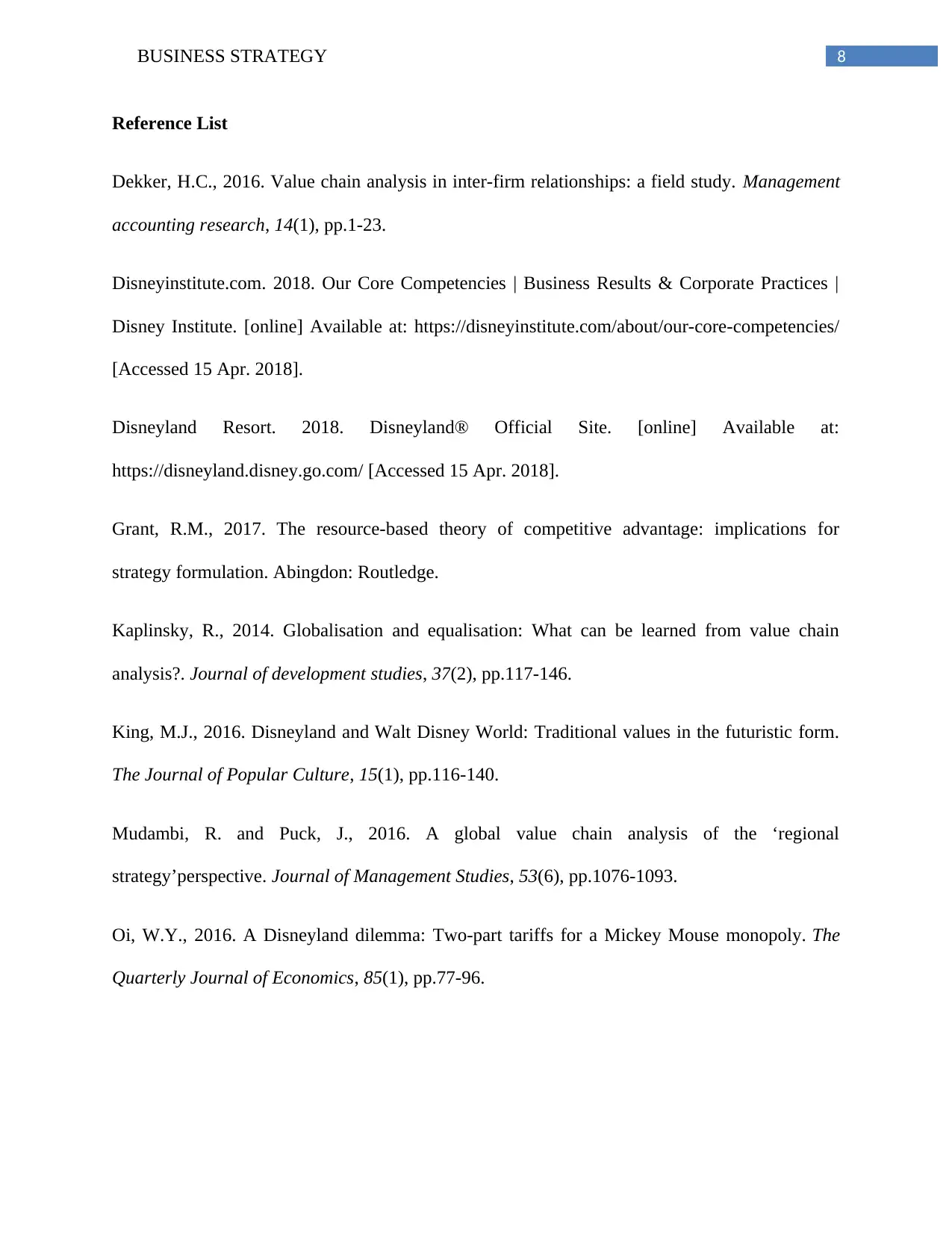
8BUSINESS STRATEGY
Reference List
Dekker, H.C., 2016. Value chain analysis in inter-firm relationships: a field study. Management
accounting research, 14(1), pp.1-23.
Disneyinstitute.com. 2018. Our Core Competencies | Business Results & Corporate Practices |
Disney Institute. [online] Available at: https://disneyinstitute.com/about/our-core-competencies/
[Accessed 15 Apr. 2018].
Disneyland Resort. 2018. Disneyland® Official Site. [online] Available at:
https://disneyland.disney.go.com/ [Accessed 15 Apr. 2018].
Grant, R.M., 2017. The resource-based theory of competitive advantage: implications for
strategy formulation. Abingdon: Routledge.
Kaplinsky, R., 2014. Globalisation and equalisation: What can be learned from value chain
analysis?. Journal of development studies, 37(2), pp.117-146.
King, M.J., 2016. Disneyland and Walt Disney World: Traditional values in the futuristic form.
The Journal of Popular Culture, 15(1), pp.116-140.
Mudambi, R. and Puck, J., 2016. A global value chain analysis of the ‘regional
strategy’perspective. Journal of Management Studies, 53(6), pp.1076-1093.
Oi, W.Y., 2016. A Disneyland dilemma: Two-part tariffs for a Mickey Mouse monopoly. The
Quarterly Journal of Economics, 85(1), pp.77-96.
Reference List
Dekker, H.C., 2016. Value chain analysis in inter-firm relationships: a field study. Management
accounting research, 14(1), pp.1-23.
Disneyinstitute.com. 2018. Our Core Competencies | Business Results & Corporate Practices |
Disney Institute. [online] Available at: https://disneyinstitute.com/about/our-core-competencies/
[Accessed 15 Apr. 2018].
Disneyland Resort. 2018. Disneyland® Official Site. [online] Available at:
https://disneyland.disney.go.com/ [Accessed 15 Apr. 2018].
Grant, R.M., 2017. The resource-based theory of competitive advantage: implications for
strategy formulation. Abingdon: Routledge.
Kaplinsky, R., 2014. Globalisation and equalisation: What can be learned from value chain
analysis?. Journal of development studies, 37(2), pp.117-146.
King, M.J., 2016. Disneyland and Walt Disney World: Traditional values in the futuristic form.
The Journal of Popular Culture, 15(1), pp.116-140.
Mudambi, R. and Puck, J., 2016. A global value chain analysis of the ‘regional
strategy’perspective. Journal of Management Studies, 53(6), pp.1076-1093.
Oi, W.Y., 2016. A Disneyland dilemma: Two-part tariffs for a Mickey Mouse monopoly. The
Quarterly Journal of Economics, 85(1), pp.77-96.
⊘ This is a preview!⊘
Do you want full access?
Subscribe today to unlock all pages.

Trusted by 1+ million students worldwide
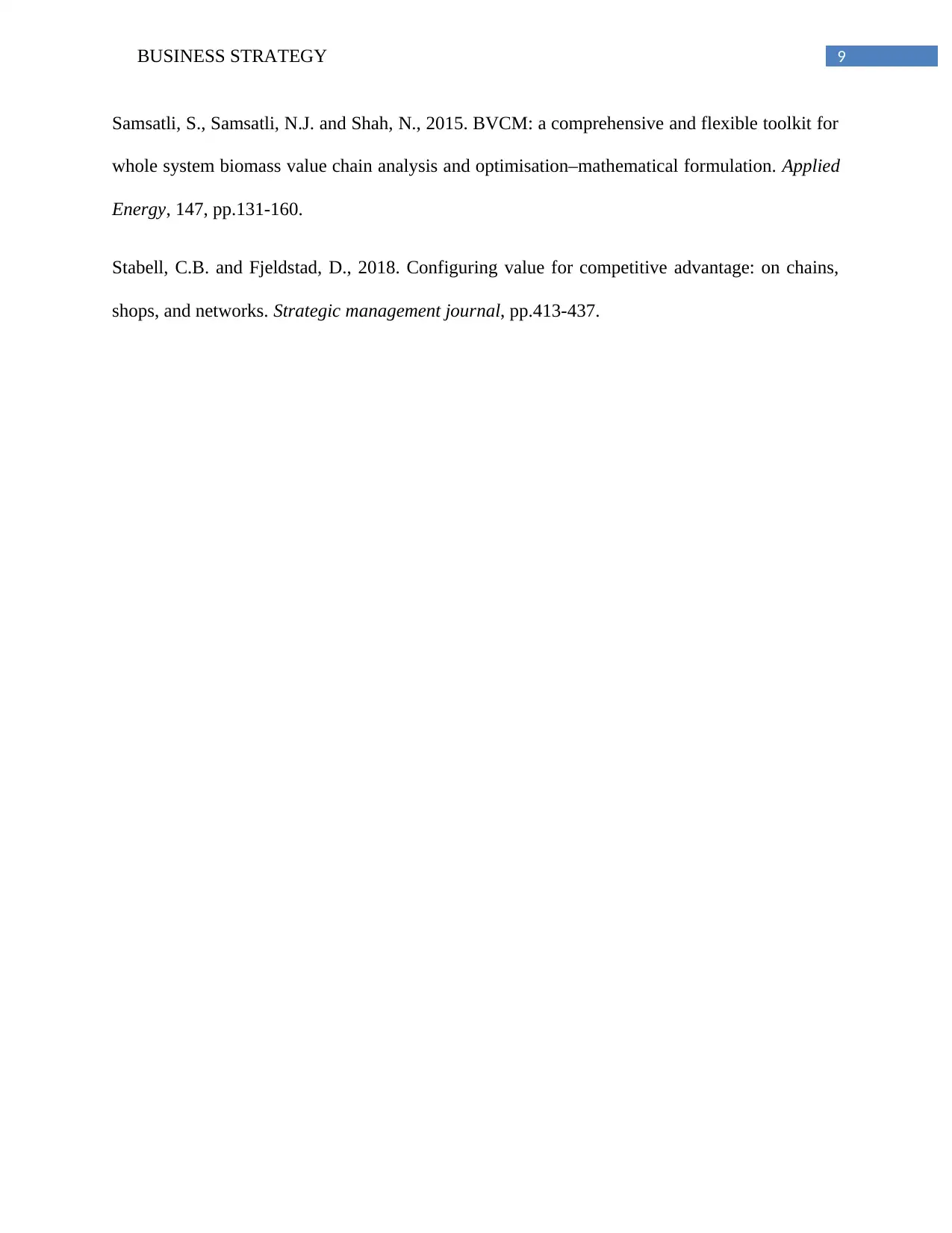
9BUSINESS STRATEGY
Samsatli, S., Samsatli, N.J. and Shah, N., 2015. BVCM: a comprehensive and flexible toolkit for
whole system biomass value chain analysis and optimisation–mathematical formulation. Applied
Energy, 147, pp.131-160.
Stabell, C.B. and Fjeldstad, D., 2018. Configuring value for competitive advantage: on chains,
shops, and networks. Strategic management journal, pp.413-437.
Samsatli, S., Samsatli, N.J. and Shah, N., 2015. BVCM: a comprehensive and flexible toolkit for
whole system biomass value chain analysis and optimisation–mathematical formulation. Applied
Energy, 147, pp.131-160.
Stabell, C.B. and Fjeldstad, D., 2018. Configuring value for competitive advantage: on chains,
shops, and networks. Strategic management journal, pp.413-437.
1 out of 10
Related Documents
Your All-in-One AI-Powered Toolkit for Academic Success.
+13062052269
info@desklib.com
Available 24*7 on WhatsApp / Email
![[object Object]](/_next/static/media/star-bottom.7253800d.svg)
Unlock your academic potential
Copyright © 2020–2025 A2Z Services. All Rights Reserved. Developed and managed by ZUCOL.





